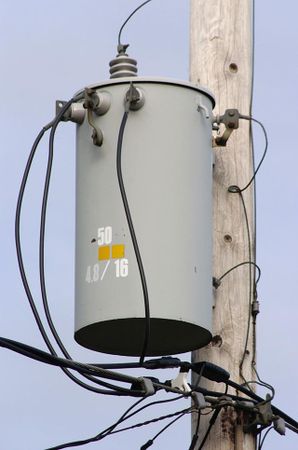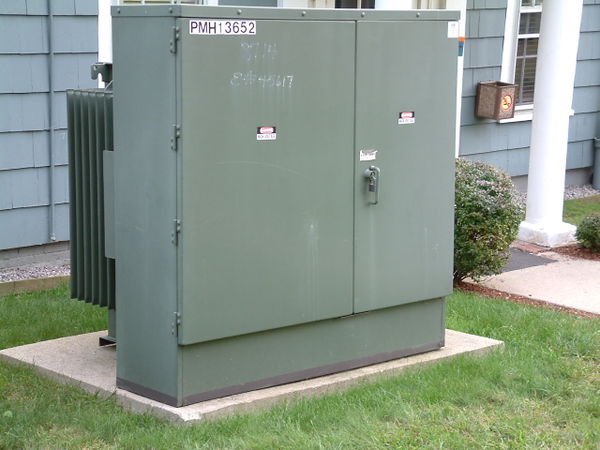Distribution transformer: Difference between revisions
J.williams (talk | contribs) m (1 revision imported) |
No edit summary |
||
| Line 1: | Line 1: | ||
[[Category:Done | [[Category:Done 2018-05-18]] | ||
[[ | <onlyinclude>A '''distribution transformer''' is the type of [[transformer]] that performs the last [[voltage]] transformation in a [[distribution grid]]. It converts the voltage used in the transmission lines to one suitable for household and commercial use, typically down to 240 [[volt]]s.</onlyinclude><ref name=a>''How Power Grids Work'' [Online]. Available: http://science.howstuffworks.com/environmental/energy/power9.htm</ref> These transformers are ''pole-mounted'' if the transmission lines run ''above'' ground (see figure 1), and they are ''pad-mounted'' (see figure 2) if the transmission lines lie ''underground'', as is the case in many suburban areas. The pad-mounted transformer is usually green and visible on the front lawns of many homes. | ||
[[ | |||
< | <gallery caption="Two types of Transformers" mode=packed heights=300px> | ||
File:Pole-mounted distribution transformer.jpeg|Figure 1. A single-phase pole-mounted distribution transformer | |||
File:Pad mounted transformer.jpg|Figure 2. A pad mounted transformer box<ref>http://www.zeppaenterprises.com/electric.html</ref> | |||
</gallery> | |||
[[ | ==Connections== | ||
Every [[utility pole]] has a [[grounding]] wire. There is also a grounding [[wire]] that accompanies the two 120 volt hot wires that come from the transformer. These two 120 volt wires are 180° out of phase so that if both [[electric current]]s are used, there is a combined voltage of 240 volts. This allows for both 120-volt and 240-volt devices to be powered by the same [[distribution grid]].<ref name=a></ref> | |||
== | == For Further Reading == | ||
For further information please see the related pages below: | |||
*[[Current transformer]] | |||
*[[Transformer]] | |||
*[[Electrical grid]] | |||
*[[Distribution grid]] | |||
*[[Connecting homes to the electrical grid]] | |||
* Or explore a [[Special:Random| random page!]] | |||
==References== | ==References== | ||
<references/> | <references/> | ||
[[Category:Uploaded]] | [[Category:Uploaded]] | ||
Revision as of 03:13, 18 May 2018
A distribution transformer is the type of transformer that performs the last voltage transformation in a distribution grid. It converts the voltage used in the transmission lines to one suitable for household and commercial use, typically down to 240 volts.[1] These transformers are pole-mounted if the transmission lines run above ground (see figure 1), and they are pad-mounted (see figure 2) if the transmission lines lie underground, as is the case in many suburban areas. The pad-mounted transformer is usually green and visible on the front lawns of many homes.
- Two types of Transformers
Figure 2. A pad mounted transformer box[2]
Connections
Every utility pole has a grounding wire. There is also a grounding wire that accompanies the two 120 volt hot wires that come from the transformer. These two 120 volt wires are 180° out of phase so that if both electric currents are used, there is a combined voltage of 240 volts. This allows for both 120-volt and 240-volt devices to be powered by the same distribution grid.[1]
For Further Reading
For further information please see the related pages below:
- Current transformer
- Transformer
- Electrical grid
- Distribution grid
- Connecting homes to the electrical grid
- Or explore a random page!
References
- ↑ 1.0 1.1 How Power Grids Work [Online]. Available: http://science.howstuffworks.com/environmental/energy/power9.htm
- ↑ http://www.zeppaenterprises.com/electric.html



